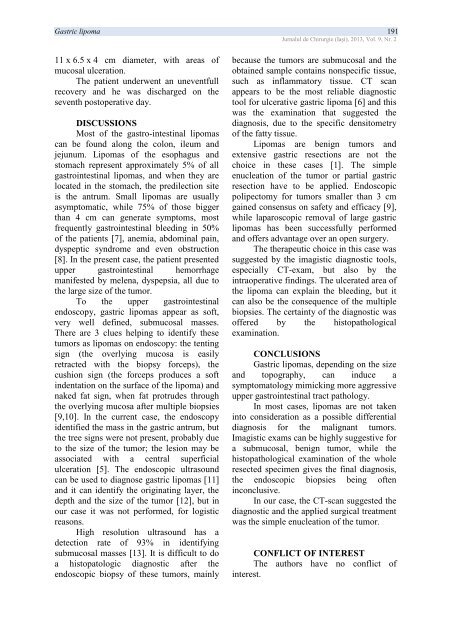PDF (5 MB) - Jurnalul de Chirurgie
PDF (5 MB) - Jurnalul de Chirurgie
PDF (5 MB) - Jurnalul de Chirurgie
You also want an ePaper? Increase the reach of your titles
YUMPU automatically turns print PDFs into web optimized ePapers that Google loves.
Gastric lipoma 191<strong>Jurnalul</strong> <strong>de</strong> <strong>Chirurgie</strong> (Iaşi), 2013, Vol. 9, Nr. 211 x 6.5 x 4 cm diameter, with areas ofmucosal ulceration.The patient un<strong>de</strong>rwent an uneventfullrecovery and he was discharged on theseventh postoperative day.DISCUSSIONSMost of the gastro-intestinal lipomascan be found along the colon, ileum andjejunum. Lipomas of the esophagus andstomach represent approximately 5% of allgastrointestinal lipomas, and when they arelocated in the stomach, the predilection siteis the antrum. Small lipomas are usuallyasymptomatic, while 75% of those biggerthan 4 cm can generate symptoms, mostfrequently gastrointestinal bleeding in 50%of the patients [7], anemia, abdominal pain,dyspeptic syndrome and even obstruction[8]. In the present case, the patient presentedupper gastrointestinal hemorrhagemanifested by melena, dyspepsia, all due tothe large size of the tumor.To the upper gastrointestinalendoscopy, gastric lipomas appear as soft,very well <strong>de</strong>fined, submucosal masses.There are 3 clues helping to i<strong>de</strong>ntify thesetumors as lipomas on endoscopy: the tentingsign (the overlying mucosa is easilyretracted with the biopsy forceps), thecushion sign (the forceps produces a softin<strong>de</strong>ntation on the surface of the lipoma) andnaked fat sign, when fat protru<strong>de</strong>s throughthe overlying mucosa after multiple biopsies[9,10]. In the current case, the endoscopyi<strong>de</strong>ntified the mass in the gastric antrum, butthe tree signs were not present, probably dueto the size of the tumor; the lesion may beassociated with a central superficialulceration [5]. The endoscopic ultrasoundcan be used to diagnose gastric lipomas [11]and it can i<strong>de</strong>ntify the originating layer, the<strong>de</strong>pth and the size of the tumor [12], but inour case it was not performed, for logisticreasons.High resolution ultrasound has a<strong>de</strong>tection rate of 93% in i<strong>de</strong>ntifyingsubmucosal masses [13]. It is difficult to doa histopatologic diagnostic after theendoscopic biopsy of these tumors, mainlybecause the tumors are submucosal and theobtained sample contains nonspecific tissue,such as inflammatory tissue. CT scanappears to be the most reliable diagnostictool for ulcerative gastric lipoma [6] and thiswas the examination that suggested thediagnosis, due to the specific <strong>de</strong>nsitometryof the fatty tissue.Lipomas are benign tumors an<strong>de</strong>xtensive gastric resections are not thechoice in these cases [1]. The simpleenucleation of the tumor or partial gastricresection have to be applied. Endoscopicpolipectomy for tumors smaller than 3 cmgained consensus on safety and efficacy [9],while laparoscopic removal of large gastriclipomas has been successfully performedand offers advantage over an open surgery.The therapeutic choice in this case wassuggested by the imagistic diagnostic tools,especially CT-exam, but also by theintraoperative findings. The ulcerated area ofthe lipoma can explain the bleeding, but itcan also be the consequence of the multiplebiopsies. The certainty of the diagnostic wasoffered by the histopathologicalexamination.CONCLUSIONSGastric lipomas, <strong>de</strong>pending on the sizeand topography, can induce asymptomatology mimicking more aggressiveupper gastrointestinal tract pathology.In most cases, lipomas are not takeninto consi<strong>de</strong>ration as a possible differentialdiagnosis for the malignant tumors.Imagistic exams can be highly suggestive fora submucosal, benign tumor, while thehistopathological examination of the wholeresected specimen gives the final diagnosis,the endoscopic biopsies being ofteninconclusive.In our case, the CT-scan suggested thediagnostic and the applied surgical treatmentwas the simple enucleation of the tumor.CONFLICT OF INTERESTThe authors have no conflict ofinterest.
















